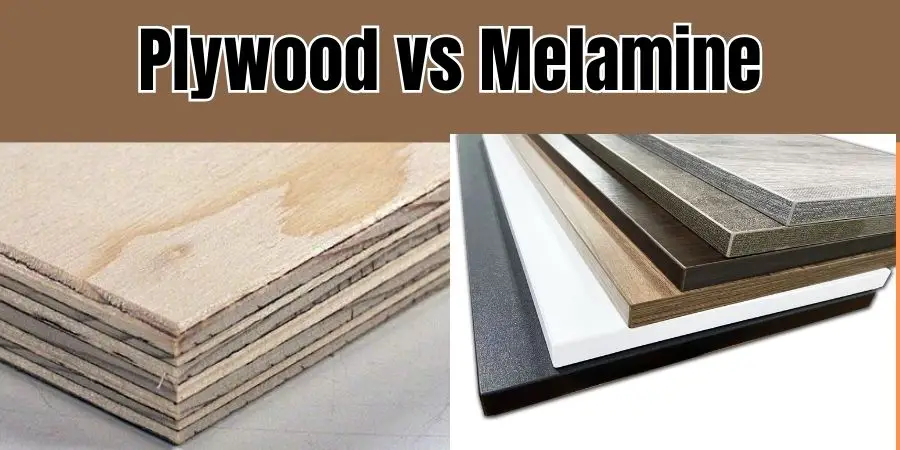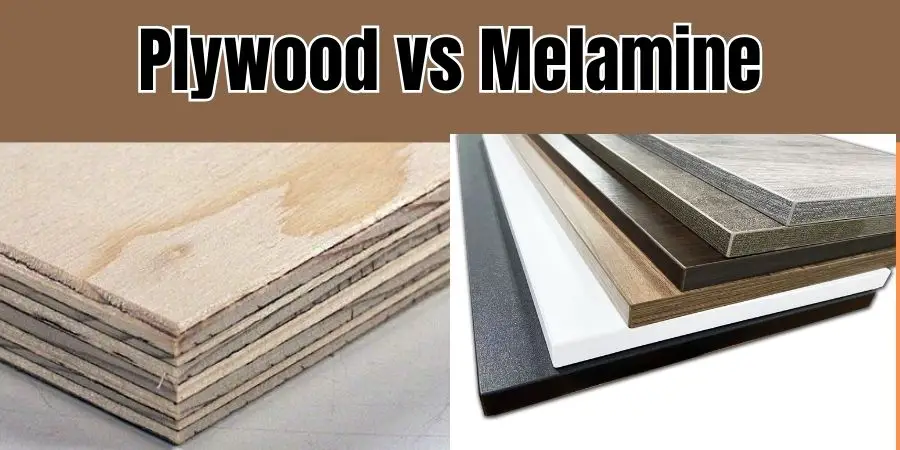When it comes to interior design and construction, choosing the right materials is essential for achieving the desired aesthetic and functionality of a space.
Two commonly used materials are plywood and melamine, but what are the differences between these two options?
Difference between Plywood vs Melamine

if you’re wondering about the difference between plywood and melamine, it basically comes down to what they’re made of.
Plywood is a type of engineered wood made up of thin layers of wood veneer glued together in a perpendicular pattern.
On the other hand, melamine is a type of particleboard coated with a layer of melamine resin, which is a fancy way of saying it’s a strong plastic.
Plywood is generally the stronger and more durable option.
It’s often used for things like flooring, cabinetry, and construction because it can handle heavy loads and take a beating.
Melamine, on the other hand, is more decorative and easier to clean, which makes it a popular choice for kitchens and bathrooms
Plywood vs Melamine: Comparison
Material Composition
- Plywood: An engineered wood product composed of several thin layers of wood veneer bonded together in a perpendicular pattern.
- Melamine: A type of particleboard coated with a layer of melamine resin, a thermosetting plastic.
Strength and Durability
- Plywood: Generally stronger and more durable, making it suitable for structural applications such as flooring, cabinetry, and construction.
- Melamine: More decorative and easier to clean, making it popular for use in kitchens and bathrooms.
Cost-Effectiveness
- Plywood: Generally less expensive than melamine, especially when compared to high-quality melamine finishes.
- Melamine: Cost can vary depending on factors such as thickness, grade, and finish.
Workability
- Plywood: Can be more challenging to work with due to its tendency to splinter and warp.
- Melamine: Easier to work with and requires less preparation.
Environmental Impact
- Plywood: Considered to be a more environmentally friendly option, made from renewable resources and can be recycled.
- Melamine: Made from particleboard, which can contain formaldehyde and other potentially harmful chemicals.
Moisture Resistance
- Plywood: Can be treated to be moisture-resistant, but if left untreated, it can be more susceptible to warping and rotting when exposed to moisture.
- Melamine: Naturally resistant to moisture and is a popular choice for use in wet areas such as bathrooms and kitchens.
Appearance and Style
- Plywood: Can have a more natural look and feel, with visible wood grain and variations in color and texture.
- Melamine: Available in a wide range of colors, patterns, and finishes, and can simulate the look of natural wood, stone, or other materials.
Application and Use
- Plywood: Suitable for a wide range of applications, including furniture, flooring, cabinetry, and construction.
- Melamine: Popular for use in interior design and decor, such as kitchen and bathroom cabinets, countertops, shelving, and decorative wall panels.
Maintenance and Care
- Plywood: Requires regular maintenance to protect against moisture and ensure durability, such as sealing, staining, or painting.
- Melamine: Requires minimal maintenance and is easy to clean with a damp cloth or mild detergent.
Should you use Melamine or plywood for?
Cabinets:
For cabinets, both plywood and melamine can be suitable depending on the specific design and style you’re going for.
If you’re looking for a more natural, rustic look, plywood may be the way to go.
On the other hand, if you’re looking for a wide range of colors and finishes, melamine can offer more variety.
Additionally, melamine can be easier to clean and maintain, making it a good choice for kitchen and bathroom cabinets.
Floors:
When it comes to flooring, plywood is generally the better choice due to its strength and durability.
Plywood can withstand heavy foot traffic and wear and tear over time.
Additionally, plywood can be sanded and refinished if it becomes damaged or scratched, which can extend its lifespan.
Melamine, on the other hand, may not hold up as well over time and may require more frequent replacement.
Kitchen Cabinets:
For kitchen cabinets specifically, both materials can be used depending on your personal preference.
Plywood can offer a more natural and classic look, while melamine can provide a wider range of colors and finishes.
However, due to the potential for moisture and heat in a kitchen, melamine may be the more practical choice due to its ease of maintenance and resistance to scratches and stains.
Roofing:
When it comes to roofing, plywood is the industry standard due to its strength and durability.
Plywood can withstand extreme weather conditions and provide a solid base for roofing materials such as shingles.
Melamine is not typically used for roofing due to its lack of strength and durability.
Shelves:
For shelves, both plywood and melamine can be suitable depending on the design and intended use.
Plywood can offer a more natural look and feel, while melamine can provide a wide range of colors and finishes.
However, if you’re looking for shelves that can support heavier objects, plywood may be the better choice due to its strength and durability.
Walls:
For decorative wall panels, melamine is often the material of choice due to its wide range of colors, patterns, and finishes.
Melamine panels can add a decorative touch to a room and are easy to clean and maintain.
Plywood can also be used for walls, but may require more finishing and maintenance to achieve a desired look.





